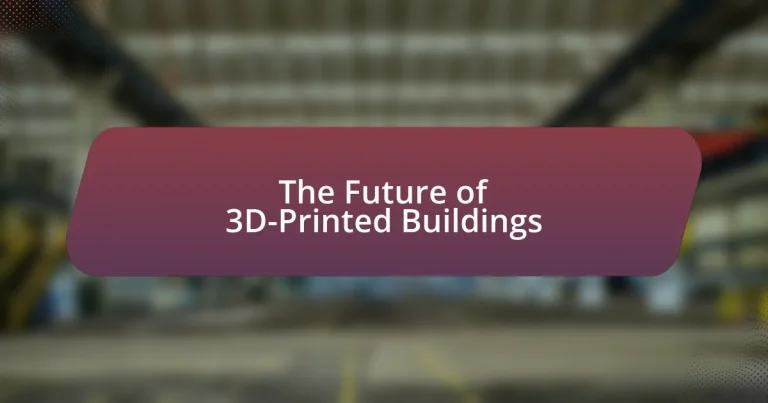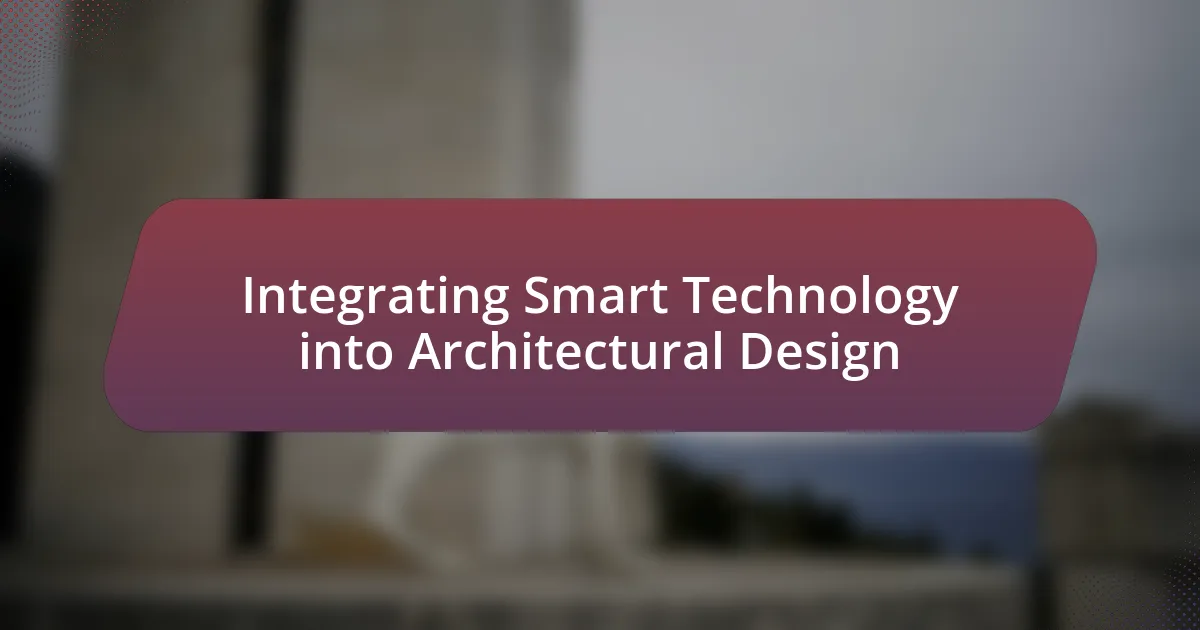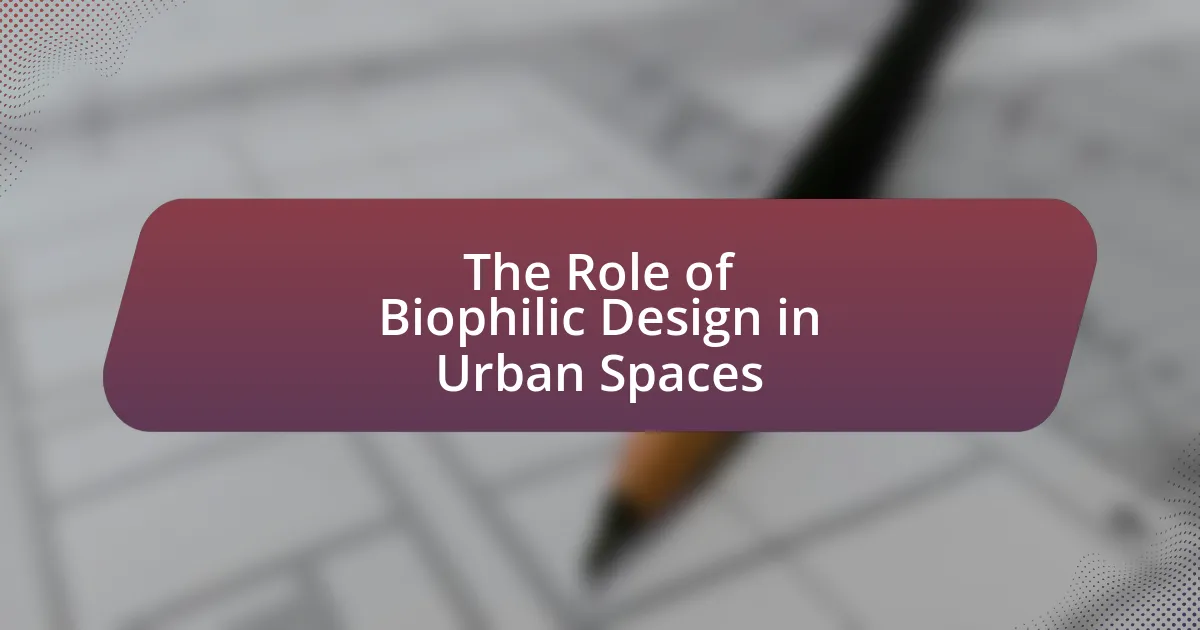The main entity of the article is 3D-printed buildings, which are constructed using additive manufacturing technology that deposits materials layer by layer. The article provides a comprehensive overview of the advantages of 3D-printed buildings, including significant reductions in construction time and costs, as well as minimized material waste. It discusses the technologies and materials used in this innovative construction method, the challenges faced, and the evolving market trends. Additionally, the article highlights the potential impact of 3D-printed buildings on society, particularly in addressing housing shortages and promoting sustainability in urban development.
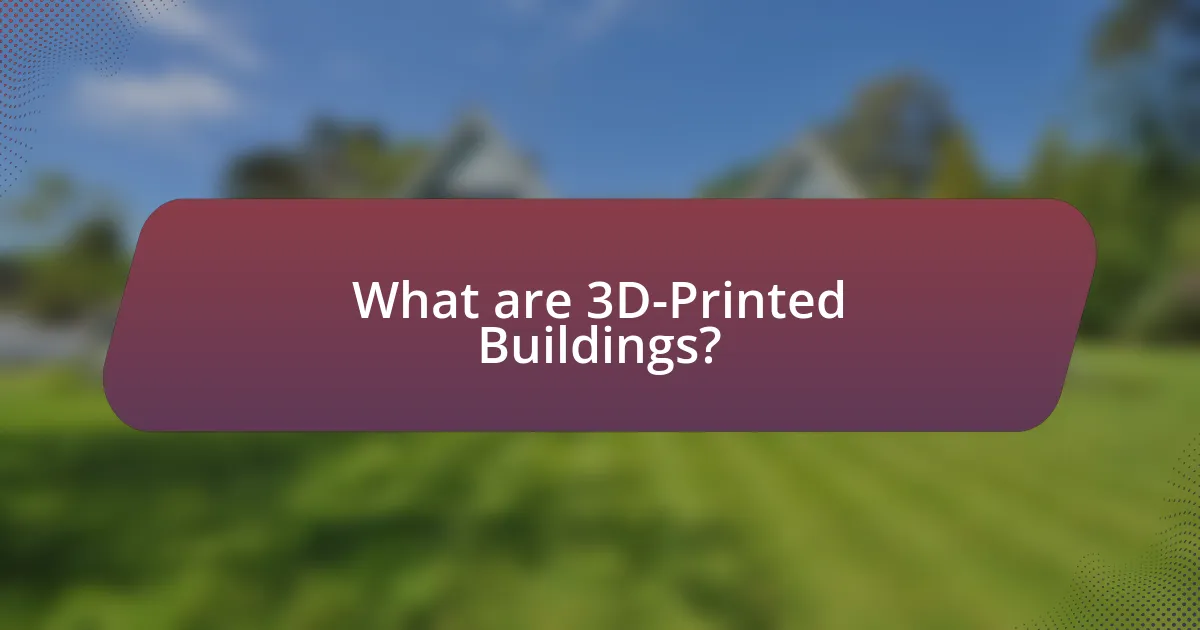
What are 3D-Printed Buildings?
3D-Printed buildings are structures created using additive manufacturing technology, where materials are deposited layer by layer to form the building. This innovative construction method allows for rapid assembly, reduced waste, and the ability to create complex designs that traditional construction methods may not easily achieve. According to a report by the World Economic Forum, 3D printing in construction can reduce labor costs by up to 50% and construction time by 70%, demonstrating its potential to revolutionize the building industry.
How does the process of 3D printing apply to construction?
The process of 3D printing applies to construction by enabling the layer-by-layer fabrication of building components, which can significantly reduce material waste and construction time. This technology allows for the creation of complex architectural designs that traditional methods cannot easily achieve, such as intricate shapes and customized structures. For instance, a study by the University of Southern California found that 3D printing can reduce construction costs by up to 50% and construction time by 70%, demonstrating its potential to revolutionize the building industry.
What technologies are used in 3D printing for buildings?
3D printing for buildings primarily utilizes technologies such as concrete extrusion, powder bed fusion, and binder jetting. Concrete extrusion involves the layer-by-layer deposition of concrete to create structural components, which has been demonstrated in projects like ICON’s 3D-printed homes in Austin, Texas. Powder bed fusion employs a laser to fuse powdered materials, allowing for intricate designs and has been used in creating building components with advanced materials. Binder jetting involves the application of a binding agent to layers of powder, enabling the construction of complex geometries and has been explored for producing architectural elements. These technologies are validated by ongoing projects and research, showcasing their effectiveness in modern construction.
What materials are commonly utilized in 3D-printed construction?
Common materials utilized in 3D-printed construction include concrete, thermoplastics, and metal alloys. Concrete is the most prevalent material due to its strength, durability, and cost-effectiveness, often enhanced with additives for improved properties. Thermoplastics, such as PLA and ABS, are used for smaller structures and components, offering flexibility and ease of printing. Metal alloys, including aluminum and titanium, are employed in specialized applications requiring high strength-to-weight ratios. These materials have been validated through numerous projects, demonstrating their effectiveness in creating sustainable and innovative building solutions.
What are the advantages of 3D-Printed Buildings?
3D-printed buildings offer several advantages, including reduced construction time, lower labor costs, and minimized material waste. The technology allows for rapid assembly, with some structures being completed in a matter of days rather than months, significantly speeding up the overall building process. Additionally, 3D printing can lower labor costs by requiring fewer workers on-site, as the automated process reduces the need for manual labor. Furthermore, the precision of 3D printing minimizes material waste, with studies indicating that traditional construction methods can waste up to 30% of materials, while 3D printing can reduce this waste to as low as 10%. These factors contribute to the efficiency and sustainability of 3D-printed buildings.
How do 3D-printed buildings reduce construction time?
3D-printed buildings significantly reduce construction time by automating the building process through additive manufacturing techniques. This technology allows for the rapid layering of materials, which can construct walls and structures in a fraction of the time compared to traditional methods. For instance, a 3D-printed home can be completed in as little as 24 to 48 hours, while conventional construction may take several weeks or months. Additionally, the use of 3D printing minimizes the need for manual labor and reduces the number of construction phases, further accelerating the overall timeline.
What cost savings can be achieved with 3D printing in construction?
3D printing in construction can achieve cost savings of up to 70% compared to traditional building methods. This significant reduction is primarily due to decreased material waste, as 3D printing uses only the necessary amount of material, minimizing excess. Additionally, labor costs are reduced since 3D printing requires fewer workers and less time to complete projects; for instance, a 3D-printed house can be constructed in a matter of days rather than weeks. Furthermore, the automation of the printing process leads to consistent quality and fewer errors, which can also contribute to overall savings.
What challenges do 3D-Printed Buildings face?
3D-printed buildings face several challenges, including material limitations, regulatory hurdles, and scalability issues. Material limitations arise from the current lack of diverse and durable materials suitable for various climates and structural requirements. Regulatory hurdles include the need for compliance with building codes and safety standards, which can vary significantly by region and may not yet account for 3D printing technologies. Scalability issues stem from the difficulty in mass-producing 3D-printed structures efficiently, as the technology is still in its developmental stages and often requires significant investment in specialized equipment and training.
What regulatory hurdles exist for 3D-printed construction?
Regulatory hurdles for 3D-printed construction include a lack of standardized building codes, uncertainty in material safety, and challenges in obtaining permits. Many jurisdictions have not yet developed specific regulations that address the unique aspects of 3D printing technology, leading to ambiguity in compliance. For instance, the International Code Council has acknowledged the need for updated codes to accommodate new construction methods, but as of now, many areas still rely on traditional building codes that may not apply effectively to 3D-printed structures. Additionally, the materials used in 3D printing, such as concrete mixtures and polymers, often lack comprehensive testing and certification, raising concerns about their long-term durability and safety. This regulatory landscape can significantly delay project timelines and increase costs for developers in the 3D-printed construction sector.
How do durability and safety concerns impact 3D-printed buildings?
Durability and safety concerns significantly impact 3D-printed buildings by influencing material selection, design standards, and regulatory compliance. The need for long-lasting structures drives the adoption of advanced materials, such as high-performance concrete and composites, which enhance structural integrity and resistance to environmental factors. Additionally, safety concerns necessitate adherence to building codes and standards, ensuring that 3D-printed structures can withstand natural disasters, such as earthquakes and floods. For instance, research published in the journal “Automation in Construction” highlights that 3D-printed buildings must undergo rigorous testing to meet safety regulations, which can affect the speed and cost of construction. Thus, addressing durability and safety is crucial for the acceptance and viability of 3D-printed buildings in the construction industry.
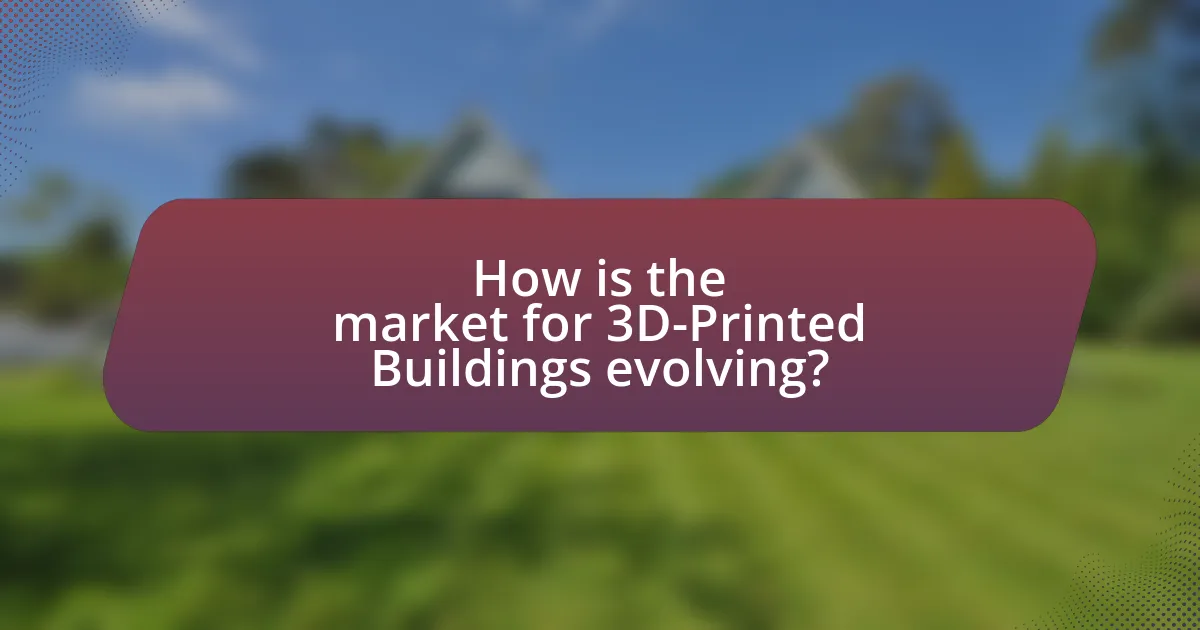
How is the market for 3D-Printed Buildings evolving?
The market for 3D-Printed Buildings is rapidly evolving, driven by advancements in technology and increasing demand for sustainable construction solutions. As of 2023, the global market for 3D-printed buildings is projected to reach approximately $1.5 billion by 2027, growing at a compound annual growth rate (CAGR) of around 20%. This growth is fueled by the ability of 3D printing to reduce construction time and costs, with some projects completed in a fraction of the time compared to traditional methods. Additionally, the use of eco-friendly materials in 3D printing aligns with the construction industry’s shift towards sustainability, further enhancing market appeal.
What trends are shaping the future of 3D-printed construction?
The future of 3D-printed construction is being shaped by several key trends, including advancements in materials, automation, and sustainability. Innovations in materials such as concrete mixtures and bio-based substances enhance structural integrity and reduce environmental impact. Automation through robotics and AI streamlines the construction process, increasing efficiency and reducing labor costs. Additionally, a growing emphasis on sustainability drives the adoption of eco-friendly practices, such as minimizing waste and utilizing renewable resources. These trends collectively indicate a transformative shift in the construction industry, making 3D printing a viable alternative to traditional building methods.
How is consumer demand influencing the adoption of 3D-printed buildings?
Consumer demand is significantly influencing the adoption of 3D-printed buildings by driving innovation and reducing costs in construction. As consumers increasingly seek affordable housing solutions and sustainable building practices, companies are responding by investing in 3D printing technology, which can lower material waste and construction time. For instance, a report from the World Economic Forum indicates that 3D printing can reduce construction costs by up to 30% and time by 50%, aligning with consumer preferences for efficiency and affordability. This shift in demand is prompting more builders to explore 3D printing as a viable option, thereby accelerating its integration into mainstream construction practices.
What role do sustainability and environmental concerns play in market growth?
Sustainability and environmental concerns significantly drive market growth in the 3D-printed buildings sector. As consumers and businesses increasingly prioritize eco-friendly practices, the demand for sustainable construction methods rises. For instance, a report by the World Economic Forum indicates that sustainable building practices can reduce carbon emissions by up to 40%, making 3D printing an attractive option due to its potential for minimizing waste and energy consumption. Additionally, the global green building market is projected to reach $364 billion by 2022, highlighting the economic benefits of adopting sustainable technologies in construction. This trend underscores the critical role that sustainability plays in shaping market dynamics and fostering innovation within the industry.
What innovations are emerging in 3D-printed building technology?
Innovations in 3D-printed building technology include the development of advanced materials, such as bio-based and recycled composites, which enhance sustainability and structural integrity. Additionally, the integration of robotics and automation in the printing process allows for faster construction times and greater precision. Research from the Massachusetts Institute of Technology highlights the use of AI algorithms to optimize design and material usage, resulting in reduced waste and improved energy efficiency. Furthermore, modular 3D printing techniques are emerging, enabling the creation of customizable and scalable housing solutions that can be rapidly deployed in response to housing shortages.
How are advancements in materials science impacting 3D printing?
Advancements in materials science are significantly enhancing the capabilities of 3D printing by introducing new materials that improve strength, durability, and versatility. For instance, the development of high-performance polymers and composite materials allows for the production of 3D-printed structures that can withstand extreme conditions, such as high temperatures and corrosive environments. Research has shown that materials like carbon fiber-reinforced plastics increase the mechanical properties of printed objects, making them suitable for structural applications in construction. Additionally, innovations in bio-based materials and concrete mixtures are enabling the creation of sustainable and eco-friendly 3D-printed buildings, aligning with modern environmental standards. These advancements not only expand the range of applications for 3D printing in construction but also enhance the efficiency and sustainability of the building process.
What new techniques are being developed for more complex designs?
New techniques being developed for more complex designs in 3D-printed buildings include advanced computational design algorithms, multi-material printing, and robotic fabrication methods. Advanced computational design algorithms enable architects to create intricate geometries that were previously unfeasible, optimizing structural performance and aesthetics. Multi-material printing allows for the integration of various materials within a single print, enhancing functionality and design versatility. Robotic fabrication methods facilitate precise construction of complex forms, improving efficiency and accuracy. These innovations are supported by research from institutions like MIT, which explores the potential of these techniques in enhancing architectural complexity and sustainability in 3D-printed structures.
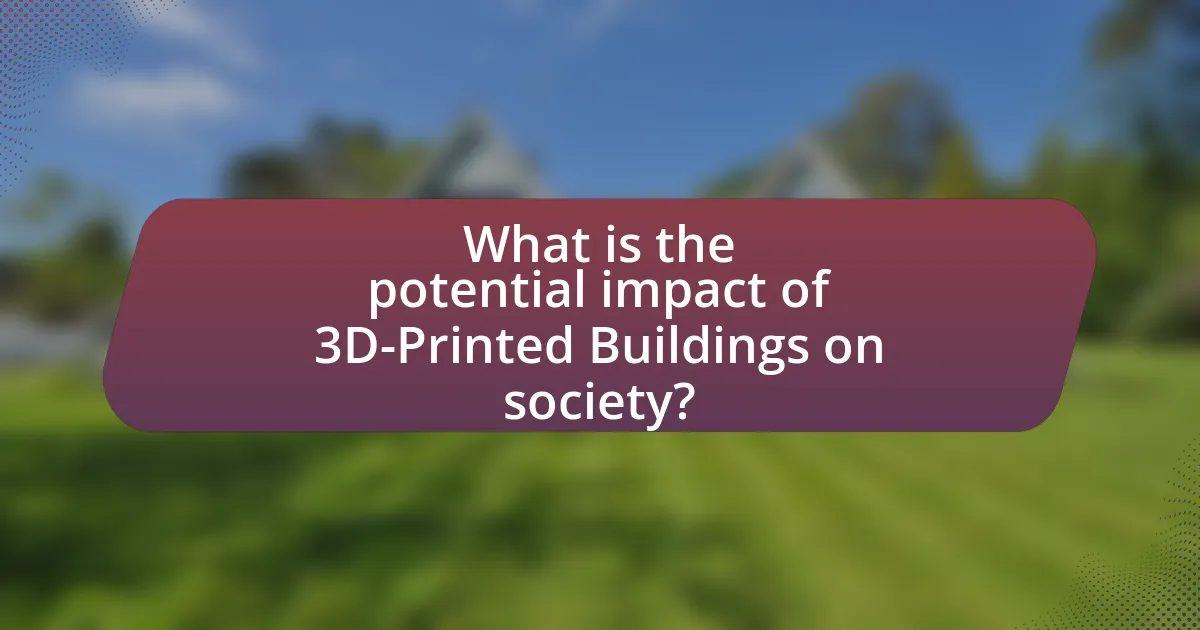
What is the potential impact of 3D-Printed Buildings on society?
3D-printed buildings have the potential to significantly transform society by reducing construction costs, accelerating building processes, and promoting sustainable practices. These structures can be produced at a fraction of traditional costs, with estimates suggesting savings of up to 70% in some cases, which can make housing more accessible. Additionally, 3D printing technology allows for rapid construction, with some projects completed in days rather than months, addressing urgent housing shortages. Furthermore, the use of eco-friendly materials in 3D printing can minimize waste and lower carbon footprints, aligning with global sustainability goals. This combination of affordability, speed, and sustainability positions 3D-printed buildings as a revolutionary force in urban development and housing solutions.
How can 3D-printed buildings address housing shortages?
3D-printed buildings can address housing shortages by significantly reducing construction time and costs. Traditional construction methods often take months or years to complete a building, while 3D printing can produce structures in a matter of days. For instance, a 3D-printed home can be built in as little as 24 hours, which allows for rapid deployment in areas with urgent housing needs. Additionally, the cost of 3D-printed homes can be up to 50% lower than conventional homes due to reduced labor and material waste. This efficiency enables the construction of affordable housing at scale, directly targeting the growing demand for accessible living spaces in urban areas.
What role can 3D printing play in disaster relief and recovery?
3D printing can significantly enhance disaster relief and recovery by enabling rapid production of essential supplies and infrastructure. This technology allows for the on-site fabrication of housing, medical supplies, and tools, which can be crucial in areas where traditional supply chains are disrupted. For instance, during the 2010 Haiti earthquake, 3D printing was proposed as a solution to quickly create temporary shelters and medical facilities, demonstrating its potential to address urgent needs effectively. Additionally, 3D printing can utilize local materials, reducing transportation costs and time, which is vital in emergency situations.
How might 3D-printed buildings contribute to urban development?
3D-printed buildings can significantly contribute to urban development by enabling faster construction, reducing costs, and minimizing waste. The technology allows for the rapid assembly of structures, which can address housing shortages in urban areas. For instance, a study by ICON demonstrated that 3D printing can reduce construction time by up to 70% compared to traditional methods. Additionally, the use of sustainable materials in 3D printing can lower the environmental impact of urban construction, aligning with green building initiatives. This innovative approach not only enhances efficiency but also promotes affordable housing solutions, making urban environments more livable and sustainable.
What are the best practices for implementing 3D-printed construction?
The best practices for implementing 3D-printed construction include selecting appropriate materials, ensuring precise design specifications, and utilizing advanced printing technologies. Selecting materials such as concrete mixtures specifically designed for 3D printing enhances structural integrity and durability. Precise design specifications, often achieved through Building Information Modeling (BIM), ensure that the printed structures meet safety and regulatory standards. Utilizing advanced printing technologies, like robotic arms or gantry systems, allows for greater accuracy and efficiency in the construction process. These practices are supported by successful projects, such as ICON’s 3D-printed homes in Austin, Texas, which demonstrate the viability and effectiveness of these methods in real-world applications.
What considerations should be made when selecting a 3D printing technology?
When selecting a 3D printing technology, key considerations include material compatibility, printing speed, resolution, cost, and scalability. Material compatibility is crucial as different technologies support various materials, impacting the final product’s properties. For instance, Fused Deposition Modeling (FDM) primarily uses thermoplastics, while Stereolithography (SLA) utilizes photopolymers, affecting durability and application. Printing speed varies significantly; technologies like Binder Jetting can produce parts faster than others, influencing project timelines. Resolution is essential for detail; SLA offers higher precision compared to FDM, which may be vital for intricate designs. Cost considerations encompass both initial investment and operational expenses, with some technologies requiring more expensive equipment and materials. Lastly, scalability is important for larger projects; technologies that can efficiently produce large volumes or sizes are preferable for construction applications. These factors collectively guide the selection process to ensure the chosen technology aligns with project requirements and goals.
How can project managers ensure quality in 3D-printed buildings?
Project managers can ensure quality in 3D-printed buildings by implementing rigorous quality control protocols throughout the construction process. This includes conducting regular inspections of materials and equipment, utilizing advanced monitoring technologies to track the printing process, and adhering to established industry standards and regulations. For instance, the use of real-time data analytics can help identify potential defects during printing, allowing for immediate corrective actions. Additionally, training personnel on best practices in 3D printing technology and material properties further enhances quality assurance. Research indicates that projects employing these strategies have reported up to a 30% reduction in construction defects, demonstrating the effectiveness of proactive quality management in 3D printing.
